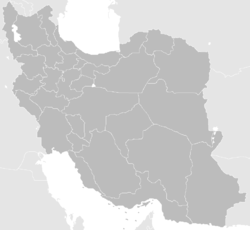| Law Enforcement Command of the Islamic Republic of Iran فرماندهی انتظامی جمهوری اسلامی ایران Fərmândēhiy-ē Ēntēzâmiy-ē Jomhuriy-ē Ēslâmiy-ē Irân | |
|---|---|
 Official logo | |
 The official flag of the Law Enforcement Command of the Islamic Republic of Iran | |
| Common name | Iranian Police |
| Abbreviation | فراجا |
| Motto | كُونُواْ قَوَّامِينَ لِلّهِ شُهَدَاء بِالْقِسْط "Be steadfast witnesses for Allah in equity" [Quran 5:8] (Heraldry slogan) |
| Agency overview | |
| Formed | April 1, 1991 |
| Preceding agency |
|
| Employees | 360,000 (including conscripts and reserves)[1] |
| Jurisdictional structure | |
| National agency | Iran |
| Operations jurisdiction | Iran |
 | |
| Map of Iran with province borders | |
| Size | 1,648,195 km2 |
| Population | 86,758,304 (2022) |
| Constituting instrument |
|
| General nature | |
| Operational structure | |
| Minister responsible | |
| Agency executive |
|
| Parent agency | General Staff of the Armed Forces |
| Notables | |
| Anniversary |
|
| Website | |
| police | |
The Law Enforcement Command of the Islamic Republic of Iran,[a] previously known as the Law Enforcement Force of the Islamic Republic of Iran[4][5] or Disciplinary Force of the Islamic Republic of Iran,[6][7][b] abbreviated as Faraja (فراجا [fæɾɒːˈd͡ʒɒː]), is the uniformed police force in Iran. The force was created in early 1992 by merging the Shahrbani (شهربانی, Šahrbâni), Gendarmerie (ژاندارمری, Žândârmeri), and Islamic Revolutionary Committees (کمیته انقلاب اسلامی, Komite enghlâb-e eslâmi) into a single force.
It has more than 260,000 police personnel, including border guard personnel, and is under the direct control of the Supreme Leader Ali Khamenei who is the head of state and Commander-in-Chief of the Armed Forces.[8] In 2003, some 40000 women became the first female members of the police force since the 1979 Iranian Revolution.[9] The Guidance Patrol, commonly called the "morality police", is a vice squad/Islamic religious police in the Law Enforcement Force of the Islamic Republic of Iran, established in 2005 with the task of arresting people who violate the Islamic dress code, usually concerning the wearing by women of hijabs covering their hair.[10][11][12]
- ^ فعالیت ٥٠٠هزار نفر از پرسنل نيروي انتظامي برای تامین امنيت ايام نوروز (in Persian). Mehr News Agency. 27 March 2014. Archived from the original on 19 April 2015. Retrieved 10 March 2015.
- ^ a b "Leader appoints Ashtari as new police chief". Tehran Times. Archived from the original on 11 March 2015. Retrieved 10 March 2015.
{{cite news}}: CS1 maint: bot: original URL status unknown (link) - ^ روز نیروی انتظامی (in Persian). Archived from the original on 19 April 2015. Retrieved 10 March 2015.
- ^ "Police Chief stresses law enforcement forces' good conditions". Archived from the original on 2018-01-12. Retrieved 2014-11-29.
- ^ "Photos: Photos: Iranian Police Forces". Archived from the original on 2 May 2015. Retrieved 21 July 2015.
- ^ Mohammadi, Majid (13 May 2013). Judicial Reform and Reorganization in 20th Century Iran. Routledge. ISBN 9781135893422. Archived from the original on 18 December 2020. Retrieved 22 October 2014.
- ^ "Supreme Leader's Remarks on the Day of Disciplinary Forces". English.irib.ir. Archived from the original on 23 October 2014. Retrieved 22 October 2014.
- ^ "Archived copy" (PDF). Archived (PDF) from the original on 2009-06-12. Retrieved 2008-07-14.
{{cite web}}: CS1 maint: archived copy as title (link) - ^ Text used in this cited section originally came from: Iran (March 2006) profile Archived 2012-01-30 at the Wayback Machine from the Library of Congress Country Studies project.
- ^ "UNICEF Iran (Islamic Republic of) – Media centre – Statement by Paul Hulshoff, UNICEF Iran Representative at the opening session of the Seminar on "Police and Justice for Children"". Archived from the original on 23 October 2014. Retrieved 21 July 2015.
- ^ "Department of Treasury and State Announce Sanctions of Iranian Security Forces for Human Rights Abuses". U.S. Department of State. Archived from the original on 4 July 2019. Retrieved 21 July 2015.
- ^ "The World Factbook". Archived from the original on 10 January 2021. Retrieved 21 July 2015.
Cite error: There are <ref group=lower-alpha> tags or {{efn}} templates on this page, but the references will not show without a {{reflist|group=lower-alpha}} template or {{notelist}} template (see the help page).